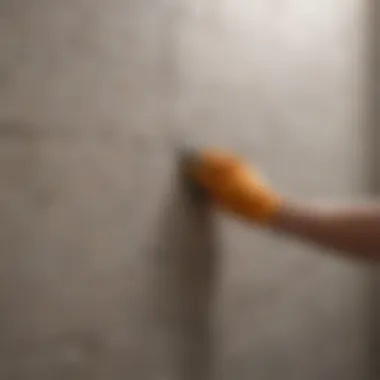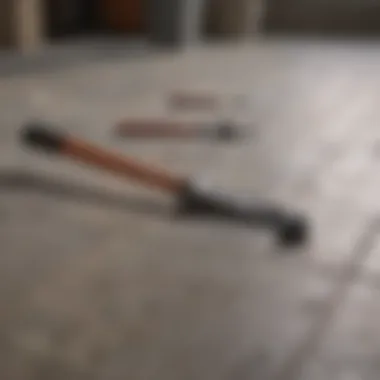Grouting Walls: Techniques and Applications Explained


Intro
Grouting is a critical aspect of both construction and home design, often overlooked by many. Proper grouting can significantly enhance the aesthetic appeal and longevity of wall finishes. For homeowners and design enthusiasts alike, understanding how to effectively grout walls can make a substantial difference in various projects.
This guide aims to break down the essential techniques and materials involved in wall grouting. It will provide insights into practical preparation steps, application methods, and maintenance considerations necessary for optimal results. As we explore this topic, it becomes clear that grouting is not merely a functional task but also an integral part of creating visually appealing and durable interiors.
Whether you are considering a home improvement project or looking to delve deeper into design elements, gaining familiarity with wall grouting is a worthwhile endeavor. Here, we will cover trending styles, color palettes, practical tips, and more, to ensure confident execution of your grouting projects.
Prolusion to Grouting Walls
Grouting is a fundamental process in the realm of construction and interior design. Understanding its significance is crucial not only for professionals but also for homeowners and design enthusiasts. The technique of grouting involves filling gaps and spaces between materials to create a strong and stable structure. In this section, we will discuss the definition of grouting and its critical role in enhancing the aesthetics and functionality of interiors.
Definition of Grouting
Grouting can be defined as the application of a dense fluid material through a space or void to solidify and bond various materials together. Typically, this involves the use of a mixture composed of cement, water, and sometimes additives, which improve its properties. The mixture is often injected, pressed, or poured into the gaps where it will harden and create a water-resistant barrier. This technical procedure not only seals but also stabilizes the surrounding building materials, ensuring their integrity over time.
Importance of Grouting in Interiors
The importance of grouting in interior settings cannot be overstated. First, it enhances the structural strength of installations such as tiles, bricks, and stones, preventing movements that may lead to cracks or dislodgement. Additionally, properly grouted surfaces contribute significantly to the aesthetics of a space.
- Sealing: Grout seals off spaces, reducing moisture penetration, which can lead to mold or damage.
- Appearance: It provides a clean finish, giving a more cohesive appearance to tiled walls or flooring.
- Durability: Quality grouting extends the lifespan of surfaces, minimizing the need for frequent repairs or replacements.
In summary, proper grouting is essential to both the visual coherence and the structural resilience of interior design elements.
Understanding Grout Types
Understanding the various types of grout is essential for any grouting project. Different types offer unique characteristics and benefits. This knowledge ensures that you select the most appropriate grout for your specific needs. Each type of grout has its own optimal use scenarios, affecting the functionality, durability, and aesthetics of your project. By grasping these distinctions, you can make informed decisions that enhance the longevity and appearance of your grouted surfaces.
Cement-based Grout
Cement-based grout is one of the most common types used in construction and renovation. It consists mainly of cement and sand, with water added to create a workable mixture. This grout is ideal for a variety of applications, particularly in tile installations. One key advantage of cement-based grout is its strength. After curing, it forms a solid bond that can withstand significant pressure.
However, it is not without its downsides. Cement-based grout is porous, meaning it can absorb moisture and stains unless sealed properly. Therefore, it’s vital to use a good quality sealer after installation to maintain its integrity. When using cement-based grout, you should also pay attention to the water-to-grout ratio during mixing to ensure optimal application.
Epoxy Grout
Epoxy grout differs from cement-based grout primarily in its composition. It combines epoxy resins and hardeners, creating a strong and waterproof bond. This makes it suitable for areas exposed to moisture, such as kitchens and bathrooms. One significant benefit of epoxy grout is its resistance to stains and chemicals. It can handle spills from oils, acids, and food without deteriorating. Additionally, its non-porous nature means it requires less maintenance over time.
It is worth noting that epoxy grout can be more challenging to work with. The mixing process requires precision, as incorrect ratios can lead to improper curing. The application can also be labor-intensive, requiring specific tools to achieve a smooth finish. Despite these challenges, epoxy grout is an excellent choice for durable and visually appealing results.
Acrylic Grout
Acrylic grout is a relatively newer option that has gained popularity for various applications. It is generally easier to work with than both cement-based and epoxy grouts. This grout contains a polymer additive, which provides flexibility and adhesion to different surfaces. One significant advantage of acrylic grout is its ability to resist cracking and shrinking, making it suitable for both interior and exterior projects.
Acrylic grout boasts a wide range of colors, allowing for creative design versatility. However, it may not be as durable as epoxy grout in high-traffic areas or conditions with heavy moisture. When applying acrylic grout, it’s important to maintain a clean workspace to prevent uneven surfaces, as it can set quickly.
Choosing the Right Grout for Your Project
Selecting the right grout is crucial for the success of your project. Factors to consider include the location of installation, exposure to moisture, and aesthetic preferences. Here are some considerations:
- Type of Surface: Different surfaces require specific types of grout for optimal adhesion.
- Moisture Exposure: For wet areas like bathrooms, epoxy grout is often the best choice.
- Traffic Level: In high-traffic areas, durability is key; thus, stronger options like epoxy may be favored.
- Aesthetic Goals: Color and texture can significantly impact the overall appearance of your project.


By carefully evaluating these factors, you can ensure that the grout you select aligns with both functional requirements and design aspirations. Investing time in understanding grout types will pay dividends in achieving lasting quality and visual appeal.
Preparation for Grouting Walls
Preparation is a key step in the grouting process. Proper preparation ensures that the grout will adhere well and perform effectively over time. Neglecting this phase can lead to a variety of issues, including weak bonds, discoloration, and premature failure of the grout. Each element of preparation must be carefully considered to achieve optimal results and enhance the longevity of the grouted surfaces.
Tools Required
Having the right tools is essential for successful grouting. Below are some crucial tools you should gather before you start:
- Trowel: A small tool with a flat blade used for spreading grout.
- Grout float: A tool designed for pressing the grout into joints and smoothing the surface.
- Bucket: For mixing the grout and holding excess grout during application.
- Sponge: To clean up excess grout from surfaces.
- Level: This ensures the surfaces are even and aligned.
- Caulk gun: Useful for applying silicone or caulk in the areas where grout will not be used.
Investing in high-quality tools can significantly enhance the precision and ease of your work.
Surface Cleaning and Repair
Before applying grout, the work surface must be thoroughly cleaned. This step is critical because any dust, grease, or debris may prevent proper adhesion. Here are the steps to ensure your surfaces are ready:
- Dusting: Use a damp cloth to wipe down the area to remove any dust or dirt.
- Inspection: Inspect for any cracks, holes, or damages in the surface. All imperfections must be repaired.
- Repairing: Fill any gaps with a suitable filler, allowing it to cure as per the manufacturer’s directions.
A clean, smooth surface is fundamental for achieving a strong bond and an aesthetically pleasing finish.
Mixing Grout: Techniques and Tips
Mixing grout properly is vital for consistent texture and performance. Here are some essential techniques and tips to keep in mind:
- Follow Instructions: Always refer to the manufacturer's recommendations for water ratios and mixing time. Each grout can have different requirements.
- Use Clean Tools: Ensure that your mixing bucket and tools are clean to prevent any contamination.
- Mixing Method: Use a power mixer for large batches to achieve a consistent mix. Alternatively, a hand mixing method is effective for smaller amounts.
- Watch for Consistency: Aim for a smooth and lump-free mixture. It should have a peanut butter-like consistency.
- Timing: Once mixed, use the grout within the timeframe specified in the instructions. Grout can set quickly.
Taking the time to prepare properly will lead to a smoother and more successful grouting experience.
Application Techniques
Understanding application techniques is fundamental for successful grouting of walls. These techniques not only impact the aesthetic quality of the finished work but also determine the longevity and performance of the grout itself. When done correctly, grouting ensures a seamless and professional look while providing robust protection against moisture and wear. Learning the right methods can avoid common pitfalls, such as uneven surfaces and weak joint integrity.
Applying Grout to Walls
Applying grout to walls is a crucial step that requires attention to detail. First, ensure that the surfaces are clean and prepared properly. Begin by mixing the grout according to manufacturer instructions; consistency is key. Once mixed, use a grout float to push the grout into the joints or spaces in the wall. This process requires a steady hand to avoid overfilling, which can lead to unsightly lumps. Keep the float at a 45-degree angle and apply firm pressure to fill the joints evenly. As you move along the wall, periodically check for gaps and ensure the grout is level with the surface.
Using the Right Tools for Application
Choosing the appropriate tools significantly influences the ease of application and overall results. Essential tools include a grout float, sponge, and caulk gun. A tile trowel may also be useful for larger areas. The grout float, especially, is designed to apply grout smoothly without damaging the wall surface. A damp sponge is necessary for cleaning up excess grout before it hardens, while a caulk gun can be helpful for applying pre-mixed grout in tubes. Ensuring tools are in good condition and suitable for the specific grout type can help streamline the application process.
Smoothing and Shaping the Grout
Once applied, the grout needs to be shaped and smoothed to achieve a polished finish. Use the edge of the grout float to remove any excess grout and to create uniform lines. Lightly press and drag the float across the joints at a consistent angle. It is vital to complete this step while the grout is still workable, as it becomes harder and more challenging to shape once it begins to set. For intricate areas or tighter spaces, finger-smoothing techniques may come in handy.
"Proper application techniques are the key to not just a visually appealing surface but to the long-term performance of grouting."
Consistency in smoothing can greatly enhance the final appearance, ensuring that all joints look uniform. Following these application techniques will lead to impressive results, boosting the overall quality of your wall work.
Post-Grouting Considerations
Understanding the post-grouting phase is crucial for ensuring the longevity and quality of any grouting project. This stage involves careful attention to curing and cleaning processes that can significantly impact the overall results. Ignoring these considerations may lead to aesthetic imperfections and structural weaknesses in the grouted walls.


Curing the Grout
Curing is a critical aspect of the grouting process. It ensures that the grout achieves its intended strength and durability. Proper curing involves maintaining adequate moisture levels and temperature conditions during the initial hardening phase. Without sufficient curing, grout can dry out too quickly, leading to issues such as cracks or uneven surfaces.
To effectively cure grout, follow these recommendations:
- Maintain Moisture: Keep the grout damp by lightly misting it with water over the course of several days. This helps ensure proper hydration, vital for the chemical processes that bond the grout particles.
- Controlled Environment: Avoid exposing the freshly grouted areas to extreme temperatures or direct sunlight. If necessary, cover the areas with plastic sheets or damp cloths to create a controlled environment and retain moisture.
- Timing: Allow the grout to cure for at least 24 to 48 hours before subjecting it to any loads or heavy moisture. The specific curing time may vary depending on the type of grout used, so always refer to the manufacturer's recommendations for best results.
Proper curing not only enhances the performance of the grout but also contributes to a visually appealing finish.
Cleaning Excess Grout from Surfaces
Cleaning excess grout from surfaces is just as essential as curing. Failure to remove surplus grout can result in unsightly stains and an uneven appearance. Here are steps to effectively clean excess grout without damaging the surrounding surfaces:
- Timing is Key: Clean the grout while it is still wet. It is much easier to remove excess grout before it hardens. Use a damp sponge or cloth to wipe away the excess.
- Gentle Pressure: Apply gentle pressure when wiping the surface to avoid damaging the grout joints. Use circular motions to lift away the excess material.
- Use of Proper Tools: Consider using a grout float for larger areas to smooth out and level the grout, then switch to a damp sponge for delicate cleaning around tiles or wall edges. Avoid using harsh chemicals that may harm the grout or tiles.
- Rinse and Repeat: After the initial cleaning, rinse your sponge or cloth frequently to avoid redepositing grime on the surface. If there are stubborn spots, a little vinegar on a damp cloth can help break them down.
Maintaining cleanliness during and after the grouting process not only enhances the aesthetic but also protects the integrity and lifespan of the grout application.
In summary, attending to post-grouting considerations, such as proper curing and effective cleaning, is vital for achieving a professional finish. Homeowners and design enthusiasts should prioritize these practices to ensure their grouted walls remain both functional and visually appealing for years to come.
Maintenance of Grouted Walls
Maintaining grouted walls is essential for preserving the aesthetic appeal and structural integrity of interiors. The longevity of grout depends significantly on proper maintenance practices. Inadequate care can lead to issues like discoloration, cracking, and even moisture infiltration. Regular maintenance not only prolongs the life of the grout but also enhances the overall look and functionality of the walls, making it vital for homeowners and design enthusiasts.
Regular Cleaning Techniques
Keeping grouted walls clean is fundamental to maintaining their appearance. Dust, stains, and grime can accumulate over time, affecting the visual aspects of the grout. Here are effective cleaning methods:
- Daily Wiping: Quickly wipe the wall with a damp cloth to remove splatters and dust. This prevents buildup.
- Weekly Cleaning: Use a mild soapy solution or a gentle cleaner. Scrub gently with a soft brush to avoid damaging the grout.
- Deep Cleaning: For significant stains or mildew, a mixture of vinegar and water may do wonders. Apply it, let it sit, and scrub lightly. Always rinse thoroughly to remove any residue.
Using a steam cleaner can also be beneficial. It can kill bacteria in the grout and lift dirt effectively without harsh chemicals. Regular cleaning not only keeps the walls looking fresh but prevents the need for more invasive repairs later.
Identifying and Repairing Damage
Damage to grout can occur due to various factors, including moisture expansion or poor installation. Detecting these issues early is crucial to avoiding extensive repairs. Common signs of damage include:
- Cracking or Crumbling: Inspect the grout regularly. Cracks can indicate underlying problems that need addressing.
- Discoloration: Dark spots or stains may suggest mildew or mold. This can be harmful to health and requires prompt action.
- Chipping: Edges or corners that look chipped may mean protection is needed.
For repairs, a straightforward approach is often effective. Here’s how to address simple damage:
- Clean the area: Remove any loose grout and clean the surface.
- Reapply Grout: Mix and apply new grout to the damaged sections. Ensure proper application to avoid gaps.
- Cure Properly: Follow the manufacturer's guidelines for curing time before exposing it to moisture.
Regular maintenance can prevent small issues from turning into major repairs, saving both time and expense.
In summary, grouted walls require consistent upkeep. Through regular cleaning and prompt repair of any damage, you can maintain the integrity and aesthetics of your interior walls. This not only enhances the beauty of the space but also ensures a durable and long-lasting finish.
Common Challenges and Solutions
Grouting walls can present various challenges that may affect the overall aesthetic and functional application of materials used within interiors. Understanding common issues can help homeowners or design enthusiasts avoid pitfalls and achieve a high-quality finish. Addressing problems like shrinkage and color variation in grout can greatly enhance the results of any grouting project, ensuring that the desired outcome meets expectations.
Issues with Grout Shrinkage
Grout shrinkage occurs when the grout dries and hardens. This can lead to gaps and cracks, impacting the appearance of the walls and reducing the integrity of the installation. The importance of selecting the correct grout and following the manufacturer's guidelines cannot be overstated. To combat shrinkage, several strategies can be employed.


- Mix Grout Correctly: Follow the instructions for mixing grout precisely. The water-to-grout ratio is pivotal. A higher water ratio may create a weaker final product.
- Choose the Right Type of Grout: Some types, like epoxy or polymer-modified grouts, are less prone to shrinkage compared to traditional cement-based grouts.
- Allow for Proper Curing Time: Avoid rushing the curing process. Ensure adequate time for the grout to set fully before exposing it to moisture or other conditions that could affect its integrity.
"The correct grout selection and application method significantly affect the likelihood of shrinkage-related issues."
Dealing with Color Variations
Color variations in grout can be a common concern for many involved in wall grouting projects. Even with careful selection, differences can arise from several factors, such as inconsistencies in mixing or variations in drying time. This can lead to an uneven appearance.
To minimize color issues, homeowners and professionals can employ the following approaches:
- Test Samples: Always test the grout on a small, inconspicuous section before applying it to the entire wall. This provides a preview of how the grout will look once dried.
- Uniform Mixing: Ensure that the grout is mixed consistently throughout the project. Stirring thoroughly can help maintain a uniform color.
- Consider Environmental Conditions: Variables like humidity and temperature can affect the drying process. Be aware of these factors and work under consistent conditions when possible.
By implementing these solutions to common challenges, the end result of any grouting project can be significantly improved. Understanding and addressing issues with grout shrinkage and color variation ensures that homeowners and design enthusiasts achieve satisfactory, long-lasting results.
Innovations in Grouting Materials
Innovations in grouting materials shape how we approach construction and renovation. These advancements offer significant benefits, such as improved durability, versatility, and environmental considerations. A better understanding of these innovations can guide homeowners and enthusiasts in making informed decisions regarding their grouting projects.
New Grout Formulations
New grout formulations have emerged, emphasizing enhanced performance characteristics. For instance, polymer-modified grouts are now popular. They can provide added flexibility and strength compared to traditional formulations. These formulations resist cracking and shrinkage, which are common concerns for many projects.
Another noteworthy development is the introduction of quick-setting grout. It allows homeowners to complete projects in a fraction of the time compared to standard products. This can be crucial for those working with tight schedules or during renovations where time efficiency is essential.
Moreover, some new grouts contain antimicrobial properties. This quality is particularly valuable in spaces prone to dampness, as it helps inhibit mold and mildew growth. Selecting a grout with these attributes can greatly enhance the longevity and cleanliness of interior spaces.
Sustainable Grouting Solutions
Sustainable grouting solutions have gained traction in recent years. The focus is on minimizing the environmental impact of construction. Many manufacturers are now producing grouts that utilize recycled materials. This not only conserves resources but also reduces waste output, making projects more eco-friendly.
Another consideration is the incorporation of low-VOC (volatile organic compounds) options. These formulations are safer for indoor air quality, making them ideal for residential environments. Homeowners increasingly seek products that contribute to better health while still being effective in performance.
Finally, some grouting solutions now showcase a higher resistance to chemical exposure. Such innovations ensure that grouted areas remain intact even in challenging environments. Utilizing sustainable materials can elevate the quality of any residential or commercial project and align with broader sustainability goals.
"In the realm of grouting, embracing innovation not only enhances quality but also aligns with a growing demand for environmentally responsible solutions."
Finale
The conclusion of this guide is critical in encapsulating the essential aspects of grouting walls. This summary serves to reinforce the importance of foundational knowledge before engaging in any grouting tasks. Grouting is not merely a task; it is a crucial element to enhance the durability and aesthetic appeal of interior spaces.
In this article, we have discussed various grout types, prepared tools, and application techniques. We explored their significance and practical considerations while also highlighting the potential challenges and innovations in the field. The integration of this information prepares readers for informed decision-making in their projects. Whether you are a homeowner, an interior design enthusiast, or simply someone interested in DIY home improvement, understanding these elements is paramount.
"Grouting not only secures tiles but also defines the look and longevity of your walls."
Recognizing the benefits of proper grouting ensures that spaces are not only visually appealing but also structurally sound. \n\n### Recapitulating the Key Points
In reviewing the contents of this guide, the following key points emerge:
- Understanding Grout Types: Each type of grout—such as cement-based, epoxy, and acrylic—serves unique purposes. A clear grasp of these differences ensures effective selections based on project needs.
- Preparation Steps: Adequate preparation, including surface cleaning and mixing techniques, is vital for achieving the best results.
- Application Methods: Utilizing correct application techniques, such as smoothing and shaping, helps to achieve a clean and professional finish.
- Maintenance Practices: Regular maintenance preserves the integrity and appearance of grouted walls over time.
- Challenges and Solutions: Being aware of potential issues, like grout shrinkage and color variations, allows for proactive management.
Future Prospects in Grouting Techniques
Looking ahead, the field of grouting is poised for continued evolution. As technology advances, new grout formulations aim to improve ease of application and durability. Sustainable solutions are becoming more prevalent, catering to the growing demand for environmentally friendly materials.
Future trends may see:
- Advanced Materials: Innovations that enhance the adhesion and overall strength of grout.
- Smart Grouts: Potential for interactive materials that may change properties based on environmental factors.
- Training Resources: Increased educational opportunities for DIY enthusiasts and professionals, fostering a greater understanding of intricate techniques.
These developments will pave the way for more efficient and effective grouting practices, ultimately benefiting those who appreciate the significance of detail in home design.















